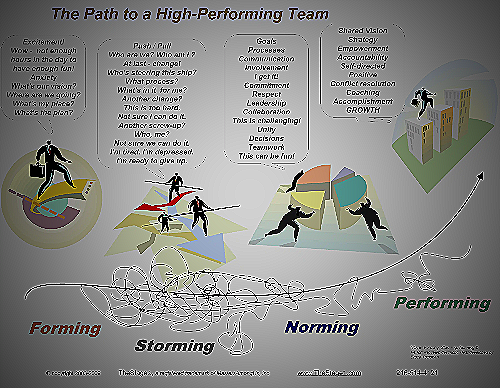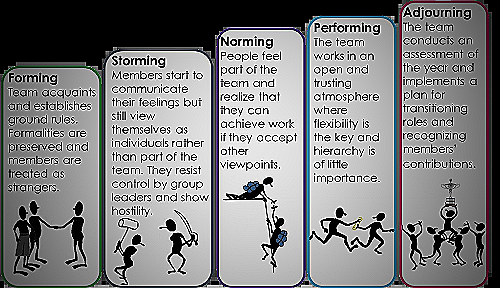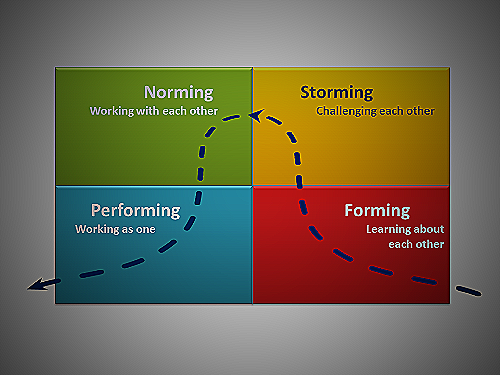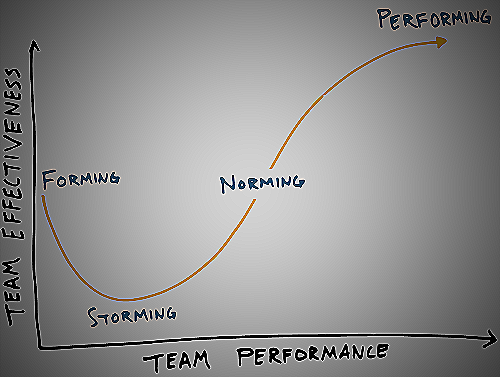Forming Norming Storming: Navigating Team Development in 2023
“Forming norming storming performing” or FSNP is a widely recognized model of group development. According to Six Sigma Daily, this model consists of four stages that a team typically goes through during a project’s life cycle.
These stages are Forming, Storming, Norming, and Performing. In each stage, the group learns to overcome obstacles and works together toward achieving their goal in a collaborative manner.
As teams work together under the FSNP model, they progress through different stages of group development. In the forming stage, team members meet each other for the first time and start to define the task at hand.
The storming stage follows, where conflict and disagreements can arise as people share their opinions and views. In the norming stage, team members begin to resolve their differences and work toward a common goal.
Finally, in the performing stage, the group works effectively together to achieve their objectives.
Understanding the FSNP model and moving through each stage effectively is essential for success in any team project. By recognizing where the group is in the model and taking appropriate actions, team members can overcome obstacles and ultimately achieve their goals.
Check out this Youtube video: “Bruce Tuckman’s Team Stages Model Explained” if you want to learn how to effectively deal with forming, norming, and storming team stages.
According to the FSNP model discovered by www.sixsigmadaily.com, the forming stage is the initial stage of teamwork where team members are introduced, and everyone is learning about each other. During this stage, team members tend to be polite and avoid conflict.
They are not yet confident in their roles or assigned tasks, and therefore they often rely on the leader to provide direction.
To successfully navigate the forming stage, the team leader must ensure that everyone feels welcomed and comfortable. The leader must establish trust and encourage open communication.
Team members must be encouraged to ask questions and clarify their roles and responsibilities. The team leader must set clear goals, provide regular feedback, and define the team’s purpose.
When this stage is complete, the team should have a clear understanding of what they need to accomplish, and everyone should be comfortable working with each other.
An example of a team in the forming stage is a new team that has never worked together before. The team members may feel very cautious and overly polite during the early stages of their collaboration.
They may hesitate to offer suggestions or critiques of others’ ideas.
Storming Stage
During the storming stage, conflicts and disagreements can arise among team members. It is essential to identify the indicators of the storming phase to effectively manage it.
According to Tuckman’s model, the storming stage is where the team learns how to overcome differences and work together as a team to tackle challenges. This stage can result in tension and conflict, but it is a crucial part of team development.
Some of the indicators of the storming stage include people forming factions, disagreements being frequent, and a strong level of emotion being displayed. To manage the storming phase, it is essential to understand each team member’s viewpoint and focus on developing trust between all members.
It is also important to establish clear communication channels and openly discuss any issues that arise.

Norming Stage
The norming stage is a crucial phase in the team’s development. It is where the team has gotten over their personal differences and has learned to work together as a unit.
During this stage, the team starts to establish its norms and values. These values shape the way a team interacts with each other and can either make or break the team.
Successfully managing the norming stage is essential to forming a high-performing team.
The norming stage can be navigated effectively by establishing open communication channels that promote collaboration and teamwork. Team members should feel comfortable voicing their opinions and suggestions.
Leaders can also establish norms that promote accountability and responsibility within the team. In doing so, each member feels valued and has ownership over their work and contribution to the team’s success.

Performing Stage
The performing stage is the fourth and final stage of team development according to various sources like www.sixsigmadaily.com and www.makingbusinessmatter.co.uk. This stage is characterized by high productivity, focus, and collaboration towards achieving a common goal.
The team has already gone through the forming, storming, and norming stages, and has now developed strong relationships, trust, and communication skills. The team members are highly committed to the team’s purpose and have a deep understanding of their roles and responsibilities, leading to efficient workflow and successful outcomes.

Team Norms and Cohesiveness
Forming, norming, and storming are vital stages in a team’s life cycle, according to various sources. The FSNP model defines the four stages of team development as they face challenges, learn to work collaboratively, and ultimately concentrate on achieving their common objective.
As team members navigate these stages, they learn to overcome obstacles, work cohesively, and gain a shared understanding of their mission. During forming and storming, team norms are established around setting expectations for attendance and dedication, which later shift towards fostering positive relationships and achieving high levels of performance in norming and performing stages.
Ultimately, the team reaches the performing stage where they are highly productive and focused on accomplishing their goals, with a shared leadership approach that has evolved into a collaborative and shared one.
According to makingbusinessmatter.co.uk, formation is the initial stage of a team’s evolution where individuals come together. Storming is the stage where individuals learn to overcome differences and work together as a team to tackle challenges.
Norming is the stage where the team is ready to focus on identifying and solving issues. Performing is the stage where the team puts their plans into action and works together to achieve successful outcomes.
Team members must progress through each stage to learn how to work together effectively and accomplish their shared goal.

When it comes to project management, teamwork, and collaboration, the stages of forming, norming, and storming are crucial. According to various sources such as www.sixsigmadaily.com, a team undergoes four essential phases during a project’s life cycle: Forming, Storming, Norming, and Performing (FSNP).
FSNP is a well-known concept that helps outline the psychological stages and hurdles a team must overcome to work as one and achieve their objectives.
In the forming stage, individuals come together to start working together on a project. This stage is critical as team members may still be getting to know each other, testing the waters, and adapting to dynamics.
In the storming stage, it’s time to tackle challenges and work together to overcome differences. This stage may encounter conflicts, and team members may need to practice open communication to resolve any issues effectively.
Implementing a collaboration tool like Slack or Asana can be beneficial in navigating the storming stage. These tools provide a platform to manage and organize tasks, and open communication channels can help teams overcome differences and rapidly respond to new challenges.
After addressing challenges, the next step is the norming stage, where the team focuses on identifying and solving issues. This stage should ensure collaboration and shared teamwork, moving past individual agendas to achieve common goals.
Collaboration tools like Trello or Monday.com can help teams centralize project information, ensure transparency, and track progress.
Finally, teams enter the performing stage where they put everything into action and work together to achieve successful outcomes. Collaboration tools can help teams achieve shared objectives by fostering a culture of teamwork and enabling members to work collaboratively in real-time.
In conclusion, collaborating with others plays a vital role in accomplishing project objectives. Understanding the stages of forming, norming, and storming, and using appropriate tools can help teams work collaboratively and achieve successful outcomes.
Challenges in Navigating Team Development
According to various sources, forming norming storming is a well-known concept that outlines the different stages a team undergoes as they work on a project. There are different variations of this model, but they all generally follow the same framework.
At the forming stage, individuals come together as a team and start to get to know each other. During the storming stage, differences and conflicts start to emerge as individuals learn to work together to tackle challenges and overcome obstacles.
In the norming stage, the team is ready to focus on identifying and solving issues as they work towards achieving their goal. Finally, in the performing stage, the team puts its plans into action and works together to achieve successful outcomes.
Team development can be quite challenging, but understanding the forming norming storming model can help managers and leaders navigate the different stages and lead their teams to success.
Measuring Team Performance
When evaluating team performance, it is important to consider the stages of forming, norming, and storming. According to Bruce Tuckman’s model, teams progress through these stages as they work on a project.
The forming stage is where individuals come together and get to know each other. In the storming stage, team members learn to overcome differences and work together to tackle challenges.
Finally, in the norming stage, the team is ready to focus on identifying and solving issues.
To measure team performance during each of these stages, tools and strategies can be used. For example, during the forming stage, it may be helpful to evaluate whether team members are communicating effectively and getting along.
In the storming stage, productivity, communication, and the ability to manage conflicts can be key indicators of performance. Finally, during the norming stage, team cohesion and collaboration may be important factors to consider.
Improving team performance during these stages may involve the use of various strategies such as the GRPI model, feedback loops, and team building. The GRPI model focuses on setting clear goals, defining roles, ensuring processes are in place, and establishing clear interpersonal relationships.
Incorporating a feedback loop allows the team to learn from their mistakes and improve their performance. Lastly, team building activities such as trust exercises, brainstorming sessions, and social events can help improve team cohesion and combat feelings of frustration.

Closing Out Your Team Journey: Adjourning Stage
In the team development process, the Adjourning stage is the final phase of Tuckman’s model of “forming norming storming performing” This is the end of the project, and the team’s work is complete; the tasks have been accomplished, and the team members move on to other assignments. The goal of this stage is to wrap up the team journey and transition out of the project together.
At this point, it is essential to acknowledge individual and group achievements, celebrate successes, and reflect on the project’s ups and downs. It is also an excellent opportunity to remember those moments, achievements, and failures that have influenced the team throughout the project.
As a team leader, it’s essential to prepare the team for the project’s end and move on to something else together. Here are some tips for the Adjourning stage of team development:
- Celebrate successes – Acknowledge and celebrate all the achievements, big or small.
- Recognize individual contributions– Take the time to recognize each team member for their unique contributions and efforts and show appreciation for their hard work.
- Reflect on the experience – Take stock of what the team has learned, the challenges faced, and how they overcame them.
- Provide closure – Help the team transition out of the project and provide closure by encouraging team members to say goodbye to each other and the project in a meaningful way.
- Encourage feedback – Ask team members to provide feedback on the team’s performance and the process as a whole. This feedback can help improve future projects and team dynamics.
In addition to the above, as a team leader, it’s also essential to set expectations for what comes next after the team project. Let the team know whether they will be working together again in the same capacity and what the future holds for them as a team.
The Adjourning stage is an opportunity to celebrate the team’s success and growth and close out the project with a sense of accomplishment, camaraderie, and closure. By following these tips, team leaders can ensure that their teams end their journey together on a positive note and are ready to move forward to future projects and opportunities.
Conclusion
Forming, norming, and storming are essential stages that teams go through during the project’s life cycle. As teams progress through these phases, they learn to overcome obstacles, cooperate effectively, and achieve their overall objectives in a collaborative manner.
It is crucial to navigate these stages successfully to ensure effective team performance and project completion. By following the FSNP or Tuckman’s model, team leaders can lead their teams through these stages and achieve better results.
References
- [alink href=’aHR0cHM6Ly93d3cubWluZHRvb2xzLmNvbS9wYWdlcy9hcnRpY2xlL25ld0xEUl84Ni5odG0=’ text=’VHVja21hbidzIFN0YWdlcyBvZiBHcm91cCBEZXZlbG9wbWVudA==’]
- [alink href=’aHR0cHM6Ly93d3cudGhlYmFsYW5jZWNhcmVlcnMuY29tL3N0YWdlcy1vZi10ZWFtLWRldmVsb3BtZW50LTQxNjA3MTU=’ text=’VGhlIEZpdmUgU3RhZ2VzIG9mIFRlYW0gRGV2ZWxvcG1lbnQ=’]
- [alink href=’aHR0cHM6Ly93d3cuYnVzaW5lc3MuY29tL2FydGljbGVzL2F2b2lkaW5nLXN0YWdlLW9uZS1mb3JtaW5nLXBpdGZhbGxzLw==’ text=’QXZvaWRpbmcgU3RhZ2UgT25lIEZvcm1pbmcgUGl0ZmFsbHM=’]

